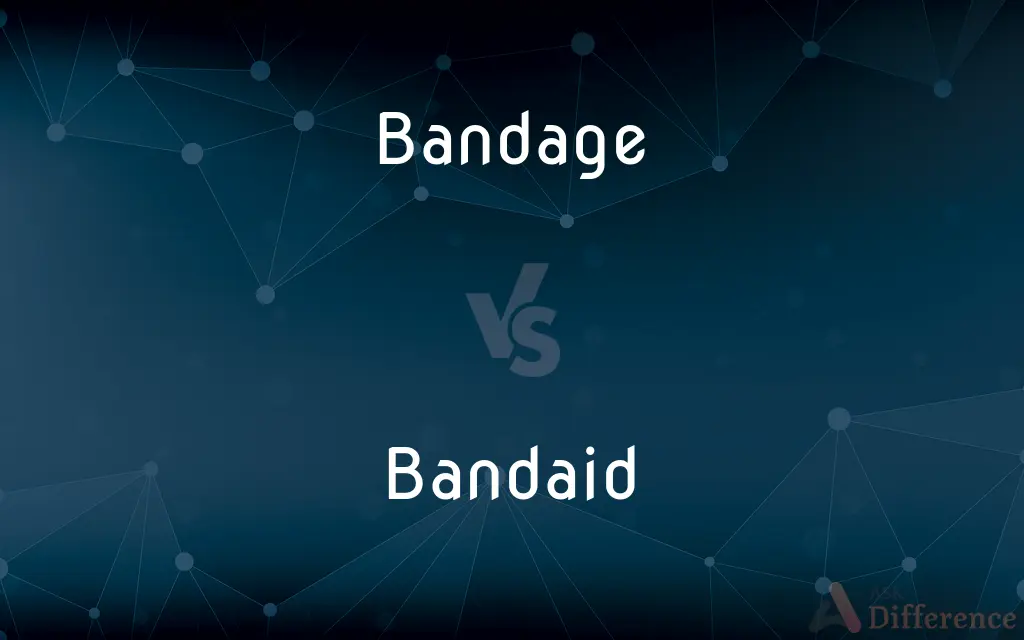Bandage vs. Bandaid — What's the Difference?
By Urooj Arif & Fiza Rafique — Updated on March 18, 2024
A bandage is a broad term for any material used to support or restrict a body part, cover wounds, or absorb fluids, while a Band-Aid is a brand name for a specific type of adhesive bandage used for minor cuts and abrasions.

Difference Between Bandage and Bandaid
Table of Contents
ADVERTISEMENT
Key Differences
Bandages come in various forms, including gauze, adhesive, and compression types, serving multiple purposes from wound dressing to supporting sprains. On the other hand, Band-Aids are a specific kind of adhesive bandage, typically small and with a sticky backing, designed for minor wounds.
While bandages can be specialized, like elastic bandages for sprain support or gauze for larger wound coverage, Band-Aids are generally used for small cuts or abrasions, offering a quick and convenient solution. Band-Aids, being a subset of adhesive bandages, are characterized by a small, absorbent pad with an adhesive backing for easy application.
Bandages are often part of medical kits and used in various medical settings, reflecting their versatility in wound care and injury support. Band-Aids, however, are more commonly found in everyday first aid kits and are favored for their ease of use and portability for minor injuries.
The term "bandage" is generic and encompasses a wide range of products, whereas "Band-Aid" is a trademarked brand name, often used generically in some regions to refer to all adhesive bandages. This distinction highlights the difference between a general category of medical supplies and a specific branded product within that category.
Comparison Chart
Type
General term for various wound coverings
Brand name for a type of adhesive bandage
ADVERTISEMENT
Purpose
Supports, restricts, covers wounds, absorbs fluids
Covers minor cuts and abrasions
Varieties
Gauze, adhesive, compression, etc.
Typically small with adhesive backing
Usage
Medical settings, first aid kits
Everyday first aid, minor injuries
Term
Generic
Trademarked brand name, often used generically
Compare with Definitions
Bandage
A piece of material used for supporting injured body parts or covering wounds.
She wrapped a bandage around the sprained ankle to provide support.
Bandaid
Features a small, absorbent pad with an adhesive backing for easy application.
The Band-Aid's adhesive backing made it easy to stick on her knee.
Bandage
Can be made from various materials, including gauze, elastic, or cloth.
The nurse used a sterile gauze bandage to dress the wound.
Bandaid
A brand of adhesive bandages for minor cuts and abrasions.
He put a Band-Aid on the small cut to keep it clean.
Bandage
Often used in medical settings for wound care and injury support.
The doctor applied a compression bandage to reduce swelling.
Bandaid
Comes in various sizes and designs, often including fun patterns for children.
The child chose a Band-Aid with cartoon characters on it.
Bandage
Can be specialized, like tubular bandages for finger injuries.
For her injured finger, a tubular bandage was the best choice.
Bandaid
Convenient for first aid kits and quick fixes for minor injuries.
She always carried Band-Aids in her purse for emergencies.
Bandage
Requires securing with clips, tape, or other fasteners.
After applying the bandage, he secured it with medical tape.
Bandaid
The name is often used generically, though it's a specific brand.
Can you hand me a Band-Aid, even though it's not the brand name?
Bandage
A bandage is a piece of material used either to support a medical device such as a dressing or splint, or on its own to provide support to or to restrict the movement of a part of the body. When used with a dressing, the dressing is applied directly on a wound, and a bandage used to hold the dressing in place.
Bandaid
Alternative spelling of band-aid
Bandage
A strip of woven material used to bind up a wound or to protect an injured part of the body
A strip of bandage
Her leg was swathed in bandages
Bandage
Bind (a wound or a part of the body) with a protective strip of material
Bandage the foot so that the ankle is supported
Bandage
A strip of material such as gauze used to protect, immobilize, compress, or support a wound or injured body part.
Bandage
To apply a bandage to.
Bandage
A strip of gauze or similar material used to protect or support a wound or injury.
Bandage
A strip of cloth bound round the head and eyes as a blindfold.
Bandage
A provisional or makeshift solution that provides insufficient coverage or relief.
This new healthcare proposal merely applies a bandage to the current medical crisis
Bandage
To apply a bandage to something.
Bandage
A fillet or strip of woven material, used in dressing and binding up wounds, etc.
Bandage
Something resembling a bandage; that which is bound over or round something to cover, strengthen, or compress it; a ligature.
Zeal too had a place among the rest, with a bandage over her eyes.
Bandage
To bind, dress, or cover, with a bandage; as, to bandage the eyes.
Bandage
A piece of soft material that covers and protects an injured part of the body
Bandage
Wrap around with something so as to cover or enclose
Bandage
Dress by covering or binding;
The nurse bandaged a sprained ankle
Bandage an incision
Common Curiosities
Can bandages be used for all types of wounds?
Bandages are versatile and can be used for a wide range of injuries, but the type of bandage and its application depend on the wound's nature.
How do I choose the right bandage?
The choice of bandage depends on the injury's type, size, and location, with considerations for needed support, absorbency, and breathability.
Are Band-Aids waterproof?
Some Band-Aids are waterproof, designed to protect wounds even when wet, but not all adhesive bandages have this feature.
Is it okay to reuse a bandage?
Most bandages, especially adhesive types like Band-Aids, are designed for single use to maintain hygiene and prevent infection.
Are there latex-free Band-Aids?
Yes, there are latex-free Band-Aids available for individuals with latex allergies or sensitivities.
What is a Band-Aid?
A Band-Aid is a brand name for an adhesive bandage, designed for small cuts and abrasions, featuring an absorbent pad and adhesive backing.
Can Band-Aids cause skin irritation?
Some people may experience skin irritation from the adhesive used in Band-Aids, especially if they have sensitive skin or allergies.
How often should I change a Band-Aid?
Band-Aids should be changed daily or more frequently if they become wet or dirty, to promote healing and prevent infection.
What's the difference between a bandage and a plaster?
A plaster is another term for a small adhesive bandage, similar to a Band-Aid, used for minor wounds, whereas a bandage is a broader term.
Can I apply a Band-Aid on a burn?
For minor burns, a Band-Aid can be applied if it covers the burn completely, but more severe burns require medical attention.
What is a bandage?
A bandage is a material used to support body parts, cover wounds, or absorb fluids, available in various types like gauze and elastic.
Do bandages help with healing?
Bandages can support the healing process by protecting the wound, absorbing exudate, and maintaining a moist environment.
What should I do if a bandage sticks to a wound?
If a bandage sticks to a wound, moisten it with sterile water or saline solution to gently remove it without damaging the healing tissue.
How do I dispose of used bandages and Band-Aids?
Used bandages and Band-Aids should be disposed of in the trash, preferably wrapped in another layer of waste to maintain hygiene.
Can I swim with a Band-Aid on?
Waterproof Band-Aids are designed to stay on in water, but it's essential to check the packaging for specific water-resistant properties.
Share Your Discovery

Previous Comparison
Clasp vs. Hasp
Next Comparison
Details vs. DetailAuthor Spotlight
Written by
Urooj ArifUrooj is a skilled content writer at Ask Difference, known for her exceptional ability to simplify complex topics into engaging and informative content. With a passion for research and a flair for clear, concise writing, she consistently delivers articles that resonate with our diverse audience.
Co-written by
Fiza RafiqueFiza Rafique is a skilled content writer at AskDifference.com, where she meticulously refines and enhances written pieces. Drawing from her vast editorial expertise, Fiza ensures clarity, accuracy, and precision in every article. Passionate about language, she continually seeks to elevate the quality of content for readers worldwide.















































